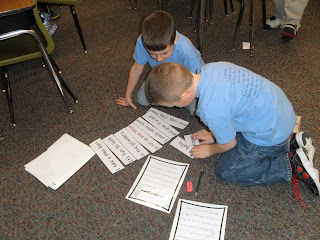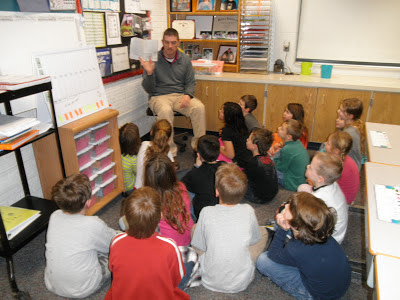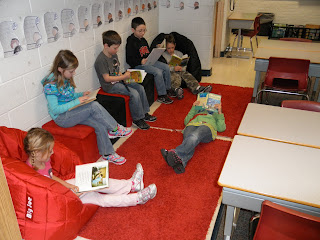Learning Targets--Helping Students Aim for
Understanding in Today's Lesson
I highly recommend that you read this book. It will really help
your understanding of what Learning Targets are and their
importance.
*I found used copies on Amazon.com-very inexpensive to
purchase ISBN 978-1-4166-1441-8
I'm going to highlight the important points that I've taken from
each chapter throughout the next few weeks so I hope you follow...
Chapter 7: Using Learning Targets to Foster Higher-Order
Thinking
*All learning targets should be judged according to how well they fit with
curricular aims and how appropriate for students. It is particularly worth
exploring learning targets about thinking skills.
We will review how to establish and
communicate learning targets that incorporate thinking skills in
student-friendly terms and how to use formative assessment and differentiated
instruction to help students reach thinking-skill targets.
*Learning Targets about Thinking Skills
Defining
Higher-Order Thinking-
Understanding higher-order thinking will
help teachers incorporate thinking skills into their learning targets for
students.
Students use higher order thinking when
they:
-Identify questions, assumptions, or
issues to investigate.
-Systematically collect, analyze, and
interpret evidence from a variety of perspectives.
-Develop coherent descriptions,
inferences, predictions, explanations, evaluations, or arguments that are
evidence-based, logical, and in context.
-Regulate and appreciate the cognitive
effort required to substantiate claims to knowledge.
*Establishing and Expressing Learning
Targets about Thinking Skills
Before you can share learning targets
about thinking skills with your students, you need to make sure that your
instructional objectives incorporate thinking skills. The conventional way to
incorporate thinking skills into instructional objectives is to use taxonomy of
thinking skills such as Bloom’s Revised Taxonomy or Webb’s Depth of Knowledge
levels, often used for state test alignment studies. There are other taxonomies
of thinking skills, too. What they all have in common is that they aim to help
educators ensure that instruction and assessment go beyond memorization and
recitation.
The hierarchical nature of these
taxonomies has led to the terms higher-order thinking and lower-order thinking.
Lower-order implies that there is something “low” in value about knowing
important facts, vocabulary, and concepts. There’s nothing wrong with learning
important facts.
What matters is that learning doesn’t
stop there. Students should be able to use the facts and concepts they know to
reason, figure things out, solve problems, write research questions and
hypotheses, and so on.
Brookhart (2010) has organized aspects
of higher-order thinking this way:
-Functioning at the “top end” of a
taxonomy of thinking skills.
-Using logic and reasoning.
-Using sound judgment.
-Identifying and solving problems.
-Being creative, seeing new patterns and
putting things together in a new way.
*Communicating Learning Targets about Thinking Skills
Instructional objectives describe
complex processes; it is not enough just to preface them with “I Can”. You need
to show students what the objectives mean for them. All potential activities
and assessment should serve the learning target. Not all students will learn
exactly the same content details and process skills (writing, speaking &
representing), but at the end of the lesson, they should all be able to say “I
can” do whatever the learning target is. If they cannot do this yet, then they
should know what to do next.
*Articulating Criteria for High-Quality Thinking
The success criteria in your learning
target is based on instructional objectives. The instructional activities all
serve these criteria, but they differ in their specific emphases and in the
processes and products they require.
Page 121 is a Sample Rubric (7.3) of Performance-Level Descriptions Added to
Success Criteria. This rubric is for a sample lesson that the book goes
into great detail.
*Understanding Higher-Order Thinking across Readiness Levels
Many people have a misconception that “higher-order”
thinking is necessarily more difficult than recall. Another common
misconception is that students have to first “learn” facts and concepts before
they can learn to apply them. Neither of these ideas is true. Level of
difficulty and level of thinking are two different aspects of learning targets.
The best learning involves students in acquiring and using facts
simultaneously. Applying new knowledge helps students see the purpose of
learning it in the first place. Educators who hold either of these
misconceptions risk shortchanging young students and low achievers of any ages.
Students who must slog through recall and drill assignments before they are
deemed “ready” to do higher-order thinking will learn that school is boring.
And they will not learn to think well.
*Higher-Order Thinking and the Learning Process
Higher-order thinking enables students
to regulate their own learning processes. Metacognition, or “thinking about
thinking,” requires reasoning about abstract concepts (like considering, “How
well am I understanding this part?”), which is necessary for student
self-assessment.
Goal setting and other aspects of
self-regulation require higher-order thinking, specifically the acts of coming
up with and then carrying out a plan that the student can reasonably expect to
lead to improvement. In a real sense, “how to learn” becomes a learning target
in its own right.
The higher-order thinking skills
involved in self-regulated learning can be organized in several ways. Boekaerts’s
(1999) model is used in much self-regulation research and also has clear
implications for classroom instruction and assessment.
She describes three types of
strategies that self-regulated learners need:
-First, self-regulated learners need cognitive
strategies. Students use cognitive strategies to deal directly with the
knowledge and skills they are learning. Cognitive strategies include rehearsal
(copying, underling, and repeating facts); elaboration (paraphrasing and
summarizing material); and organization (outlining and problem solving).
-Second, self-regulated learners need metacognitive
strategies. Metacognitive strategies include planning (deciding what to do
and in what order and with what resources); monitoring comprehension and
performance; and evaluation the quality of one’s learning.
-Third, self-regulated learners need motivational
strategies. Students need to have the expectation that they can learn the
content or perform the skill to be attained. They need to value the learning,
seeing the knowledge or skill as important; either in its own right or for its
instrumental value in getting to some other goal—as, for example, a student who
wants to be an engineer knows that it is important to learn calculus. Students
need to have positive effective responses to the learning—interest, enjoyment,
or some other positive emotion.
Page 127 7.5—Sample Learning Targets and
Criteria for Success for Some Self-Regulation Skills
*Creativity in Learning Targets
Creativity is about defining
problems or tasks in a new light and putting ideas together in new ways. Creativity
is not being cute, artistic, or even interesting. The misconception that
creativity means making things appealing—whether visually, as in a beautiful
report cover, or verbally, as in a tug-at-the-heartstrings story—often leads to
the assignment of “points” for creativity in work that is not, in fact,
creative.
Students who are creative…
-Recognize the importance of a deep
knowledge base and continually work to learn new things.
-Are open to new ideas and actively seek
them out.
-Find source material for ideas in a
wide variety of media, people, and events.
-Look for ways to organize and reorganize
ideas into different categories and combinations, and then evaluate whether the
results are interesting, new or helpful.
-Use trial and error when they are not
sure of how to proceed, viewing failure as an opportunity to learn.
Aspects of these skills can become
learning targets. Students can learn to look for what is “new” about the work
of authors, artists, scientists, historians, and mathematicians. They can learn
to try for “new” applications or cross-references in their own work. We
shortchange students when we communicate in our words and in our assignments
that creativity means visual or verbal pizzazz. True creativity is what moves
society forward, and students will not develop their creativity unless they aim
for it like any other learning target.
If you want students to be creative,
assign work that requires them to produce a new product or reorganize existing
ideas (not just facts on a poster or bulletin board) in a new way. Make
creativity an explicit learning target. Allow or even require students to
find and use source material beyond a set of assigned readings. Above all, make
sure that the generation of new ideas—whether in writing, speech, illustration,
or construction—connects to the rest of the content that the student is
supposed to be learning and not to something tangential like the cover or the format
of a project.
The teacher needs to have complete
directions for the assignment. We are mostly concerned with the learning target
and the criteria for success expressing to students, in terms they can
understand, what creative work should look like.
**To further communicate the learning
target and criteria for success, the teacher might draft two or three examples
of varying quality and have students discuss how the examples meet or don’t
meet the criteria.
Looking Forward
This chapter and the previous have shown
that every step of instruction and formative assessment should be grounded in a
learning target. But at some point, instruction must end. At the end of the
instruction, it’s time for summative assessment—time to ascertain and report
what students have learned. In most classrooms and school, that means grading,
which is the subject of Chapter 8.
As I’ve said each week, this is a great book with a lot of
examples, tables and charts that I’m not including in the post. I highly
recommend that you purchase a copy of the book for further information and
study.
Until next week…






































